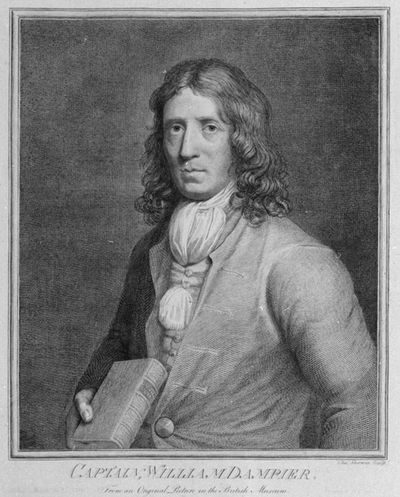Annotation:Dampier: Difference between revisions
No edit summary |
m (Text replacement - "garamond, serif" to "sans-serif") |
||
| (One intermediate revision by one other user not shown) | |||
| Line 1: | Line 1: | ||
=='''Back to [[{{BASEPAGENAME}}]]'''== | =='''Back to [[{{BASEPAGENAME}}]]'''== | ||
---- | ---- | ||
<p><font face=" | <p><font face="sans-serif" size="4"> | ||
'''DAMPIER.''' English, Country Dance Tune (cut time). C Major. Standard tuning (fiddle). AAB. The melody and dance directions are unique to the various publications and editions of London music publisher John Walsh, beginning with his '''English Country Dancing Master''' of 1718. The title likely refers to English explorer William Dampier [https://en.wikipedia.org/wiki/William_Dampier] (1651-1715), the first Englishman to explore parts of what is today Australia, and the first person to circumnavigate the world three times. Dampier rescued William Selkirk, a former crewmate, who is thought to have inspired Daniel Defoe to write '''Robinson Crusoe''' (1719). [[File:dampier.jpg|400px|thumb|left|William Dampier]] | '''DAMPIER.''' English, Country Dance Tune (cut time). C Major. Standard tuning (fiddle). AAB. The melody and dance directions are unique to the various publications and editions of London music publisher John Walsh, beginning with his '''English Country Dancing Master''' of 1718. The title likely refers to English explorer William Dampier [https://en.wikipedia.org/wiki/William_Dampier] (1651-1715), the first Englishman to explore parts of what is today Australia, and the first person to circumnavigate the world three times. Dampier rescued William Selkirk, a former crewmate, who is thought to have inspired Daniel Defoe to write '''Robinson Crusoe''' (1719). [[File:dampier.jpg|400px|thumb|left|William Dampier]] | ||
<br> | <br> | ||
<br> | <br> | ||
</font></p> | </font></p> | ||
<p><font face=" | <p><font face="sans-serif" size="4"> | ||
''Source for notated version'': | ''Source for notated version'': | ||
<br> | <br> | ||
<br> | <br> | ||
</font></p> | </font></p> | ||
<p><font face=" | <p><font face="sans-serif" size="4"> | ||
''Printed sources'': | ''Printed sources'': Walsh ('''Complete Country Dancing-Master, Volume the Fourth'''), London, 1740; No. 166. | ||
<br> | <br> | ||
<br> | <br> | ||
</font></p> | </font></p> | ||
<p><font face=" | <p><font face="sans-serif" size="4"> | ||
''Recorded sources'': <font color=teal></font> | ''Recorded sources'': <font color=teal></font> | ||
</font></p> | </font></p> | ||
Latest revision as of 12:11, 6 May 2019
Back to Dampier
DAMPIER. English, Country Dance Tune (cut time). C Major. Standard tuning (fiddle). AAB. The melody and dance directions are unique to the various publications and editions of London music publisher John Walsh, beginning with his English Country Dancing Master of 1718. The title likely refers to English explorer William Dampier [1] (1651-1715), the first Englishman to explore parts of what is today Australia, and the first person to circumnavigate the world three times. Dampier rescued William Selkirk, a former crewmate, who is thought to have inspired Daniel Defoe to write Robinson Crusoe (1719).

Source for notated version:
Printed sources: Walsh (Complete Country Dancing-Master, Volume the Fourth), London, 1740; No. 166.
Recorded sources:
